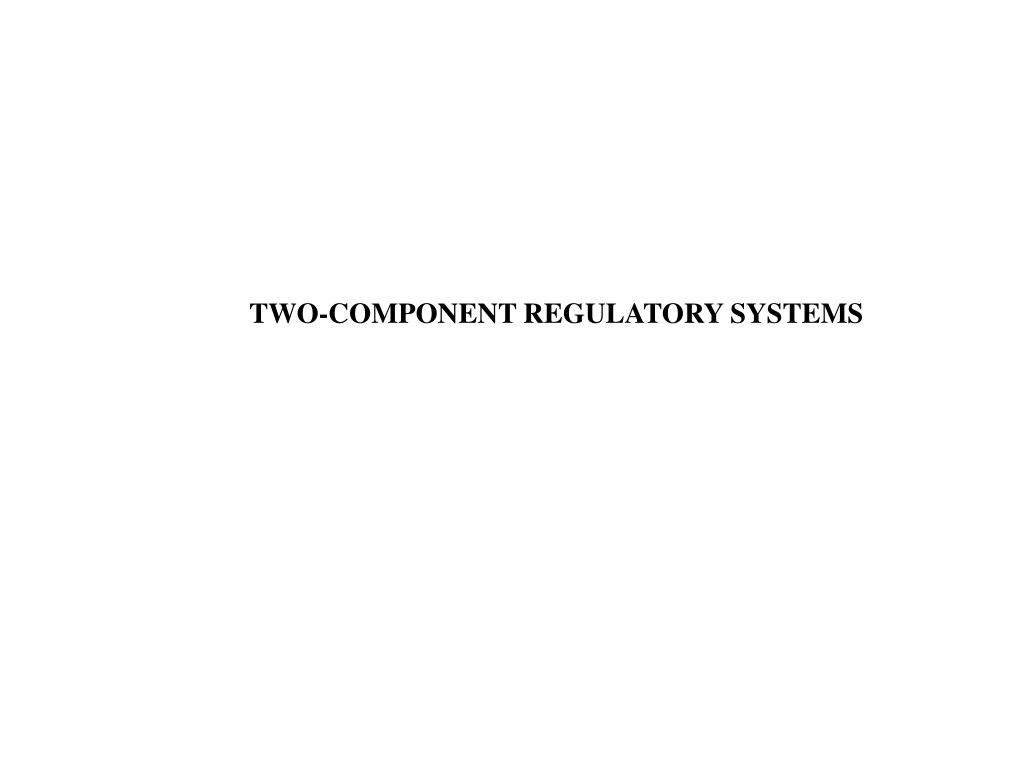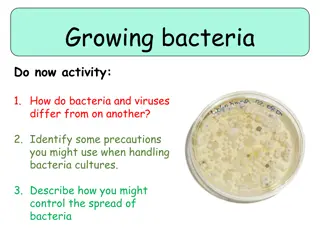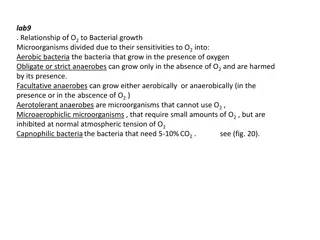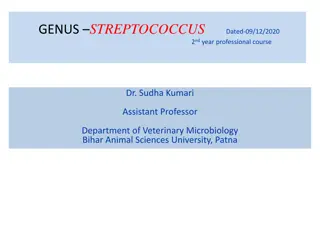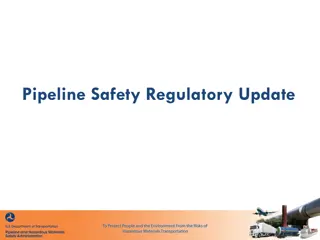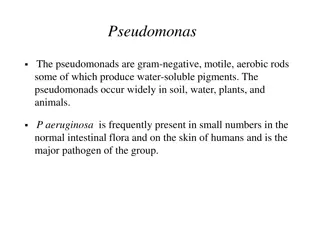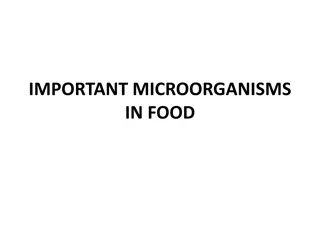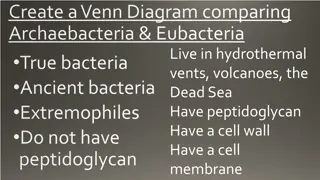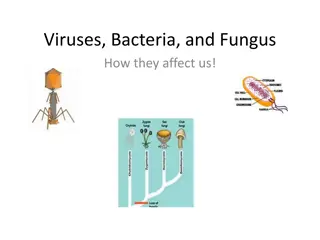Understanding Two-Component Regulatory Systems in Bacteria
Two-component regulatory systems play a crucial role in enabling bacteria to sense, respond, and adapt to various environmental conditions. These systems involve signal transduction through histidine kinases, response regulators, and phosphorylation reactions, ultimately leading to the modulation of gene expression. Explore how these systems function and their significance in bacterial physiology.
Download Presentation

Please find below an Image/Link to download the presentation.
The content on the website is provided AS IS for your information and personal use only. It may not be sold, licensed, or shared on other websites without obtaining consent from the author. Download presentation by click this link. If you encounter any issues during the download, it is possible that the publisher has removed the file from their server.
E N D
Presentation Transcript
Two-component signal transduction systems enable bacteria to sense, respond, and adapt to a wide range of environments, stressors, and growth conditions. Signal transduction can occur through the transfer of phosphoryl groups from adenosine triphosphate ( ATP ) to a specific histidine residue in the histidine kinases (HK). A variant of the two-component system is the phospho-relay system. Two-component systems: Two-component systems serve as a basic stimulus-response coupling mechanism to allow organisms to sense and respond to changes in many different environmental conditions. They typically consist of a membrane-bound histidine kinase that senses a specific environmental stimulus and a corresponding response regulator that mediates the cellular response, mostly through differential expression of target genes. Signal transduction: Signal transduction occurs when an extracellular signaling molecule activates a cell surface receptor. In turn, this receptor alters intracellular molecules creating a response. Histidine kinase: Histidine Kinases (HK) are multifunctional, typically transmembrane, proteins of the transferase class that play a role in signal transduction across the cellular membrane.
Two-component systems serve as a basic stimulus-response coupling mechanism allowing organisms to sense and respond to changes in many different environmental conditions. They typically consist of a membrane -bound histidine kinase that senses a specific environmental stimulus and a corresponding response regulator that mediates the cellular response. Two component signaling systems are widely occurring in prokaryotes whereas only a few two-component systems have been identified in eukaryotic organisms. Signal transduction occurs through the transfer of phosphoryl groups from adenosine triphosphate (ATP) to a specific histidine residue of a response regulator by histidine kinases (HK). This is an autophosphorylation reaction. Histidine kinases are typically homodimeric transmembrane proteins containing a histidine phosphotransfer domain and an ATP binding domain. Response regulators may consist of an N-terminal Receiver or Regulatory domain and a C-terminal Effector domain involved in DNA- binding transcriptional regulator enzymatic activity (CheB or RegA), protein-protein interactions
Subsequently the histidine kinase catalyzes the transfer of the phosphate group on the phosphorylated histidine residues to an aspartic acid residue on the response regulator (RR). Phosphorylation causes the response regulator s conformation to change, usually activating an attached output domain, which then leads to the stimulation (or repression) of expression of target genes. The level of phosphorylation of the response regulator controls its activity. Some HK are bifunctional, catalysing both the phosphorylation and dephosphorylation of their response regulator. The input stimuli can regulate either the kinase or phosphatase activity of the bifunctional HK.
Two-component signal transduction systems enable bacteria to sense, respond and adapt to a wide range of environments, stressors and growth conditions. Some bacteria can contain as many as 200 two-component systems that need tight regulation to prevent unwanted cross-talk. These pathways have been adapted to respond to a wide variety of stimuli, including nutrients, cellular redox state, changes in osmolarity, quorum signals, antibiotics, temperature, chemoattractants, pH and more. In E. coli the EnvZ/OmpR osmoregulation system controls the differential expression of the outer membrane porin proteins OmpF and OmpC. The KdpD sensor kinase proteins regulate the kdpFABC operon responsible for potassium transport in bacteria including E. coli and Clostridium acetobutylicum. The N-terminal domain of this protein forms part of the cytoplasmic region of the protein, which may be the sensor domain responsible for sensing turgor pressure.
System Variants (Phosphorelays) Some histidine kinases are hybrids that contain an internal receiver domain. In these cases, a hybrid HK autophosphorylates and then transfers the phosphoryl group to its own internal receiver domain, rather than to a separate RR protein. . The phosphoryl group is then shuttled to histidine phosphotransferase (HPT) and subsequently to a terminal RR, which can evoke the desired response. This system is called a phosphorelay. Almost 25% of bacterial HKs are of the hybrid type, as are the large majority of eukaryotic HKs.
Signal transducing histidine kinases are the key elements in two-component signal transduction systems. Examples of histidine kinases are EnvZ, which plays a central role in osmoregulation, and CheA, which plays a central role in the chemotaxis system. Histidine kinases usually have an N-terminal ligand-binding domain and a C- terminal kinase domain, but other domains may also be present. The kinase domain is responsible for the autophosphorylation of the histidine with ATP, the phospho transfer from the kinase to an aspartate of the response regulator, and (with bifunctional enzymes ) the phospho transfer from aspartyl phosphate back to ADP or to water. The kinase core has a unique fold, distinct from that of the Ser/Thr/Tyr kinase superfamily. Chemotaxis is a well studied phosphorelay regulatory system.
The proteins CheW and CheA bind to the receptor. The activation of the receptor by an external stimulus causes autophosphorylation in the histidine kinase, CheA, at a single highly-conserved histidine residue. CheA in turn transfers phosphoryl groups to conserved aspartate residues in the response regulators CheB and CheY (CheA is a histidine kinase and it does not actively transfer the phosphoryl group. The response regulator CheB takes the phosphoryl group from CheA. This mechanism of signal transduction is called a two-component system and is a common form of signal transduction in bacteria. CheY induces tumbling by interacting with the flagellar switch protein FliM, inducing a change from counter-clockwise to clockwise rotation of the flagellum. Change in the rotation state of a single flagellum can disrupt the entire flagella bundle and cause a tumble.
HKs can be roughly divided into two classes: orthodox and hybrid kinases. Most orthodox HKs, typified by the Escherichia coli EnvZ protein, function as periplasmic membrane receptors and have a signal peptide and transmembrane segment(s) that separate the protein into a periplasmic N- terminal sensing domain and a highly conserved cytoplasmic C-terminal kinase core. Members of this family, however, have an integral membrane sensor domain. Not all orthodox kinases are membrane bound, e.g., the nitrogen regulatory kinase NtrB (GlnL) is a soluble cytoplasmic HK. Hybrid kinases contain multiple phosphodonor and phosphoacceptor sites and use multi-step phospho-relay schemes instead of promoting a single phosphoryl transfer. In addition to the sensor domain and kinase core, they contain a CheY-like receiver domain and a His-containing phosphotransfer (HPt) domain.
The Hpr Serine/threonine kinase PtsK(a phosphocarrier protein of the phosphoenolpyruvate-dependent sugar phosphotransferase system) is the sensor in a multicomponent phosphorelay system in control of carbon catabolic repression in bacteria. This kinase is unusual in that it recognizes the tertiary structure of its target and is a member of a novel family unrelated to any previously described protein phosphorylating enzymes. X-ray analysis of the full-length crystalline enzyme from Staphylococcus xylosus at a resolution of 1.95 A shows the enzyme to consist of two clearly separated domains that are assembled in a hexameric structure resembling a three-bladed propeller. The blades are formed by two N-terminal domains each, and the compact central hub assembles the C-terminal kinase domains.
Signaling in Bacteria Signaling in bacteria, known as quorum sensing, enables bacteria to monitor extracellular conditions, ensure sufficient amounts of nutrients are present, and avoid hazardous situations. There are circumstances, however, when bacteria communicate with each other. The first evidence of bacterial communication was observed in a bacterium that has a symbiotic relationship with Hawaiian bobtail squid. When the population density of the bacteria reached a certain level, specific gene expression was initiated: the bacteria produced bioluminescent proteins that emitted light. Because the number of cells present in the environment (the cell density) is the determining factor for signaling, bacterial signaling was named quorum sensing.
Quorum sensing uses autoinducers as signaling molecules. Autoinducers are signaling molecules secreted by bacteria to communicate with other bacteria of the same kind. The secreted autoinducers can be small, hydrophobic molecules, such as acyl- homoserine lactone (AHL), or larger peptide-based molecules. Each type of molecule has a different mode of action. When AHL enters target bacteria, it binds to transcription factors, which then switch gene expression on or off. The peptide autoinducers stimulate more complicated signaling pathways that include bacterial kinases. The changes in bacteria following exposure to autoinducers can be quite extensive. The pathogenic bacterium Pseudomonas aeruginosa has 616 different genes that respond to autoinducers.
Mechanism of quorum sensing: It is the feedback control system. Bacteria continuously produce a small amount of signal called auto inducer. Most of the Gram-positive bacteria produce auto inducer which are acylhomoserine lactones (AHLs). Staphylococcus aureus and other bacteria produce peptide auto inducers. E. coli and S. typhimurium produce a quorum sensing molecule of 1 kDalton. These extracellular inducers are diffused out. Besides, bacteria also recognise the presence of auto inducer. The bacterial membrane protein acts both as receptor of auto inducer and activator of gene transcription. Vibrio fischeri produces luminescence and is the best studied quorum sensing system.
Luminescence is associated with lux operon system which consists of two main regulatory genes luxl and luxR and other genes (luxCDABEG) which synthesize chemicals to produce light. LuxI encodes a protein which catalyses the synthesis of a wide range of AHL . LuxR encodes a protein which acts both as a receptor for AHL and as a transducer of the signal that activates the other genes of lux operon. The luxCDABEG genes are expressed after binding AHL to the luxR protein. The luxA and luxB genes synthesise the - and - subunits of bacterial luciferase. The other genes encode polypeptides which facilitate the synthesis of the substrate and produces light. Autoinducer of V. fischeri is N-(3-oxo-hexanoyl)-L- homoserine lactone.
Quorum sensing as a virulence mechanism: In addition to V. fischeri, there is a large number of Gram-negative bacteria which produce AHLs to quorum sense. These are medically important bacteria, for example Pseudomonas aeruginosa, Proteus mirabilis, Serratia liquefaciens and Yersinia enterocolitica. In these bacteria LuxI/LuxA homologues are involved in quorum sensing system. P. aeruginosa utilises two quorum systems, the las and rhl. The las operon expresses LasR protein which is similar to LuxR and acts as transcriptional activator in the presence of PA1(Pseudomonas autoinducer 1) of Pseudomonas. The LasI (the Luxl homologue) produces AHL. The autoinducer of P. aeruginosa at a threshold concentration switch on a group of virulence gene including lasB, lasA apv and toxA
The rhl system is the second quorum sensing system which involves RhIR (the transcriptional activator protein) along with the autoinducer (N-butyryl-L- homoserine lactone) synthesised by RhIR. This quorum sensing system results in production of extra virulence factor e.g. elastase which cleaves and inhibits the interleukin-2 (the key host defence cytokines). The las system is dominant which is activated before the rhl system. Many Gram-positive bacteria use oligopeptide as signalling molecules. For example, two different peptides are secreted by Bacillus subtilis. These are necessary for competence (ability for DNA uptake) and sporulation. In Staphylococcus aureus, a locus agr controls the expression of many virulence factors, namely exotoxins, capsular polysaccharide type 8 and V8 protease. An octapeptide quorum sensing autoinducer is encoded by the agr locus which induces the agr locus. The quorum sensing autoinducer interacts with host defence system and inhibits the albeit at high concentration.
